HR4052QA: Managing People in Organisations - Workbook Solution
VerifiedAdded on 2023/06/12
|23
|4785
|412
Report
AI Summary
This document presents a student workbook solution for the module 'Managing People in Organisations,' covering weeks 2-11. It includes answers to questions related to recruitment methods, selection methods, diversity management, equality, diversity, and inclusion, supported by relevant theories and empirical evidence using Harvard referencing. Topics covered include the rational approach to recruitment, job descriptions vs. person specifications, encouraging diversity in recruitment, selection interview reliability and validity, competency frameworks for interviews, diversity training effectiveness, alternative diversity management interventions, challenges of COVID-19 on adult learners' employability, the importance of coaching by line managers, performance review practices, and academic writing, referencing and plagiarism. The workbook aims to reflect on learning developed from seminar activities and class discussions.
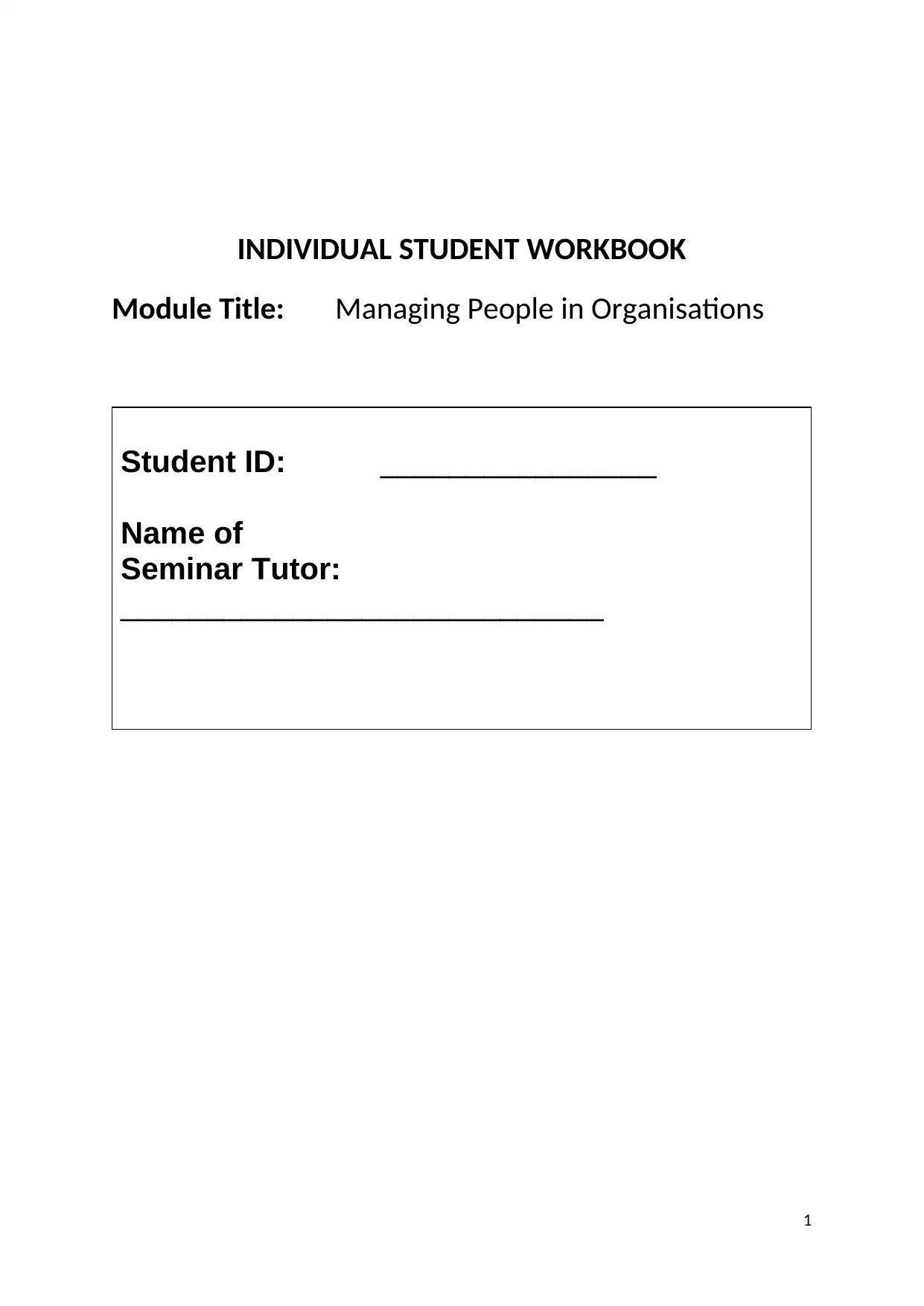
INDIVIDUAL STUDENT WORKBOOK
Module Title: Managing People in Organisations
Student ID: ________________
Name of
Seminar Tutor:
____________________________
1
Module Title: Managing People in Organisations
Student ID: ________________
Name of
Seminar Tutor:
____________________________
1
Paraphrase This Document
Need a fresh take? Get an instant paraphrase of this document with our AI Paraphraser

Table of Contents
Introduction...........................................................................................................................................3
Week 2..................................................................................................................................................4
Week 3..................................................................................................................................................5
Week 4..................................................................................................................................................6
Week 5..................................................................................................................................................7
Week 6..................................................................................................................................................8
Week 7..................................................................................................................................................9
Week 8................................................................................................................................................10
Week 9................................................................................................................................................11
Week 10..............................................................................................................................................12
Week 11..............................................................................................................................................13
Reference list.......................................................................................................................................14
Appendices..........................................................................................................................................15
2
Introduction...........................................................................................................................................3
Week 2..................................................................................................................................................4
Week 3..................................................................................................................................................5
Week 4..................................................................................................................................................6
Week 5..................................................................................................................................................7
Week 6..................................................................................................................................................8
Week 7..................................................................................................................................................9
Week 8................................................................................................................................................10
Week 9................................................................................................................................................11
Week 10..............................................................................................................................................12
Week 11..............................................................................................................................................13
Reference list.......................................................................................................................................14
Appendices..........................................................................................................................................15
2
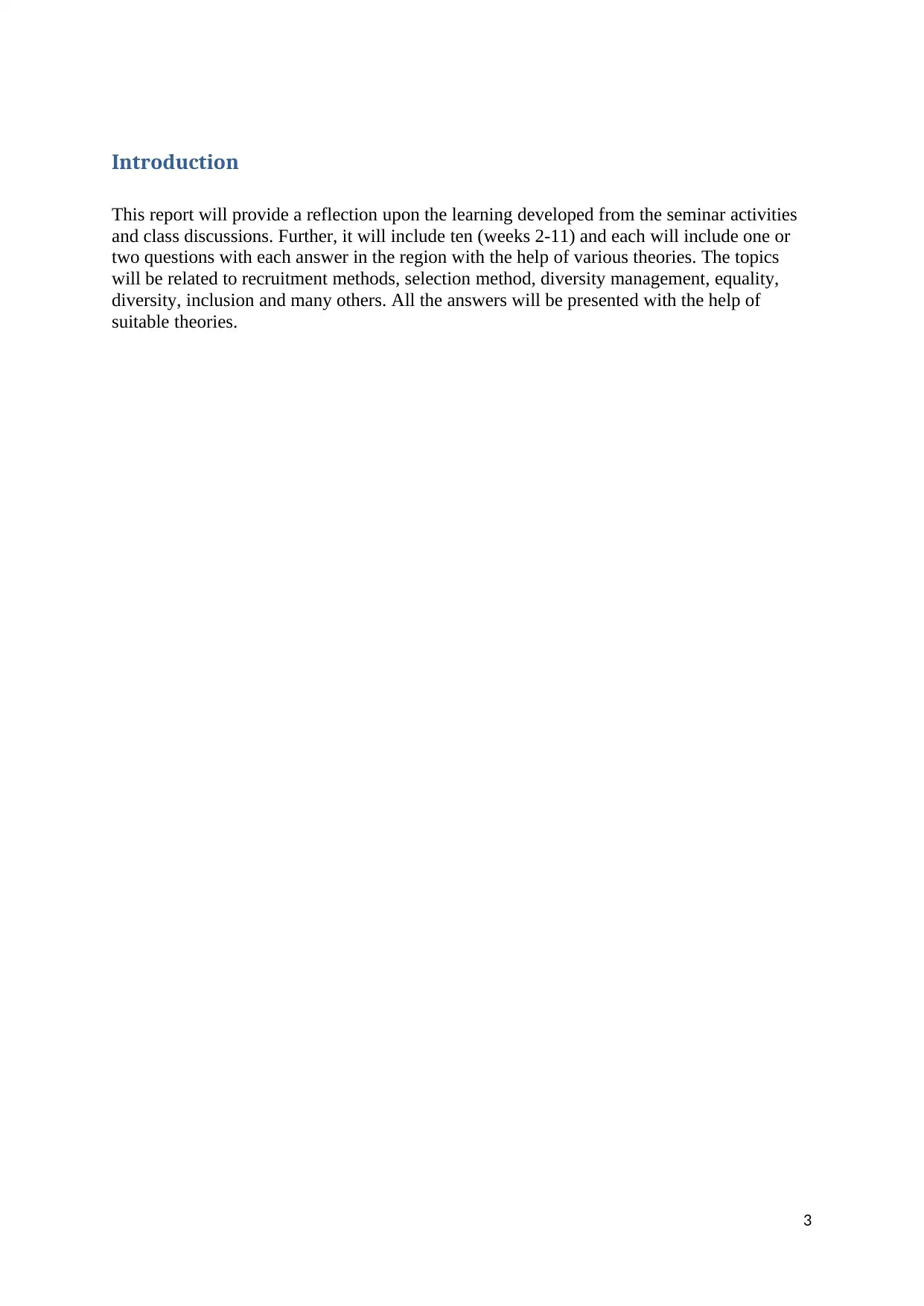
Introduction
This report will provide a reflection upon the learning developed from the seminar activities
and class discussions. Further, it will include ten (weeks 2-11) and each will include one or
two questions with each answer in the region with the help of various theories. The topics
will be related to recruitment methods, selection method, diversity management, equality,
diversity, inclusion and many others. All the answers will be presented with the help of
suitable theories.
3
This report will provide a reflection upon the learning developed from the seminar activities
and class discussions. Further, it will include ten (weeks 2-11) and each will include one or
two questions with each answer in the region with the help of various theories. The topics
will be related to recruitment methods, selection method, diversity management, equality,
diversity, inclusion and many others. All the answers will be presented with the help of
suitable theories.
3
⊘ This is a preview!⊘
Do you want full access?
Subscribe today to unlock all pages.

Trusted by 1+ million students worldwide
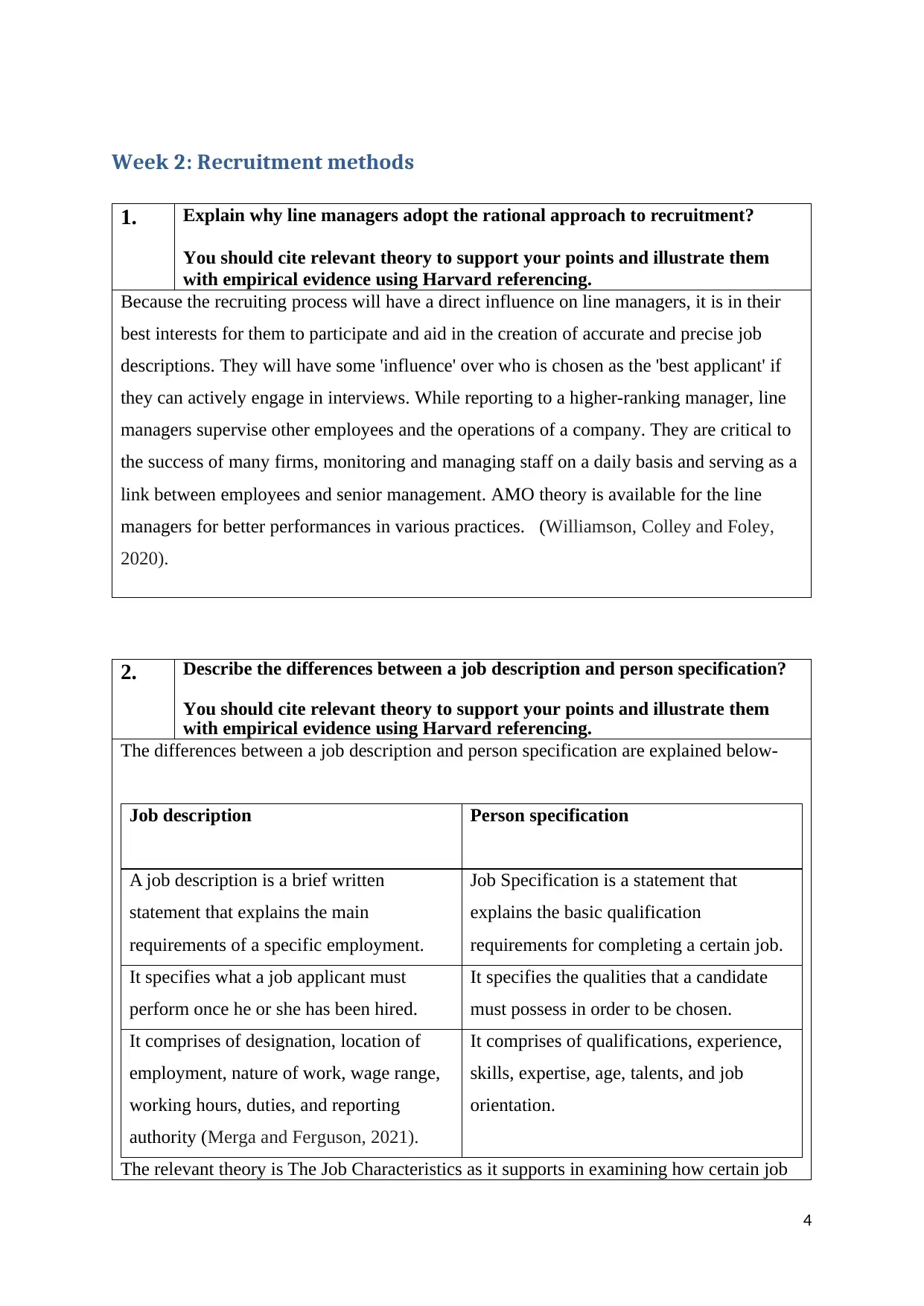
Week 2: Recruitment methods
1. Explain why line managers adopt the rational approach to recruitment?
You should cite relevant theory to support your points and illustrate them
with empirical evidence using Harvard referencing.
Because the recruiting process will have a direct influence on line managers, it is in their
best interests for them to participate and aid in the creation of accurate and precise job
descriptions. They will have some 'influence' over who is chosen as the 'best applicant' if
they can actively engage in interviews. While reporting to a higher-ranking manager, line
managers supervise other employees and the operations of a company. They are critical to
the success of many firms, monitoring and managing staff on a daily basis and serving as a
link between employees and senior management. AMO theory is available for the line
managers for better performances in various practices. (Williamson, Colley and Foley,
2020).
2. Describe the differences between a job description and person specification?
You should cite relevant theory to support your points and illustrate them
with empirical evidence using Harvard referencing.
The differences between a job description and person specification are explained below-
Job description Person specification
A job description is a brief written
statement that explains the main
requirements of a specific employment.
Job Specification is a statement that
explains the basic qualification
requirements for completing a certain job.
It specifies what a job applicant must
perform once he or she has been hired.
It specifies the qualities that a candidate
must possess in order to be chosen.
It comprises of designation, location of
employment, nature of work, wage range,
working hours, duties, and reporting
authority (Merga and Ferguson, 2021).
It comprises of qualifications, experience,
skills, expertise, age, talents, and job
orientation.
The relevant theory is The Job Characteristics as it supports in examining how certain job
4
1. Explain why line managers adopt the rational approach to recruitment?
You should cite relevant theory to support your points and illustrate them
with empirical evidence using Harvard referencing.
Because the recruiting process will have a direct influence on line managers, it is in their
best interests for them to participate and aid in the creation of accurate and precise job
descriptions. They will have some 'influence' over who is chosen as the 'best applicant' if
they can actively engage in interviews. While reporting to a higher-ranking manager, line
managers supervise other employees and the operations of a company. They are critical to
the success of many firms, monitoring and managing staff on a daily basis and serving as a
link between employees and senior management. AMO theory is available for the line
managers for better performances in various practices. (Williamson, Colley and Foley,
2020).
2. Describe the differences between a job description and person specification?
You should cite relevant theory to support your points and illustrate them
with empirical evidence using Harvard referencing.
The differences between a job description and person specification are explained below-
Job description Person specification
A job description is a brief written
statement that explains the main
requirements of a specific employment.
Job Specification is a statement that
explains the basic qualification
requirements for completing a certain job.
It specifies what a job applicant must
perform once he or she has been hired.
It specifies the qualities that a candidate
must possess in order to be chosen.
It comprises of designation, location of
employment, nature of work, wage range,
working hours, duties, and reporting
authority (Merga and Ferguson, 2021).
It comprises of qualifications, experience,
skills, expertise, age, talents, and job
orientation.
The relevant theory is The Job Characteristics as it supports in examining how certain job
4
Paraphrase This Document
Need a fresh take? Get an instant paraphrase of this document with our AI Paraphraser
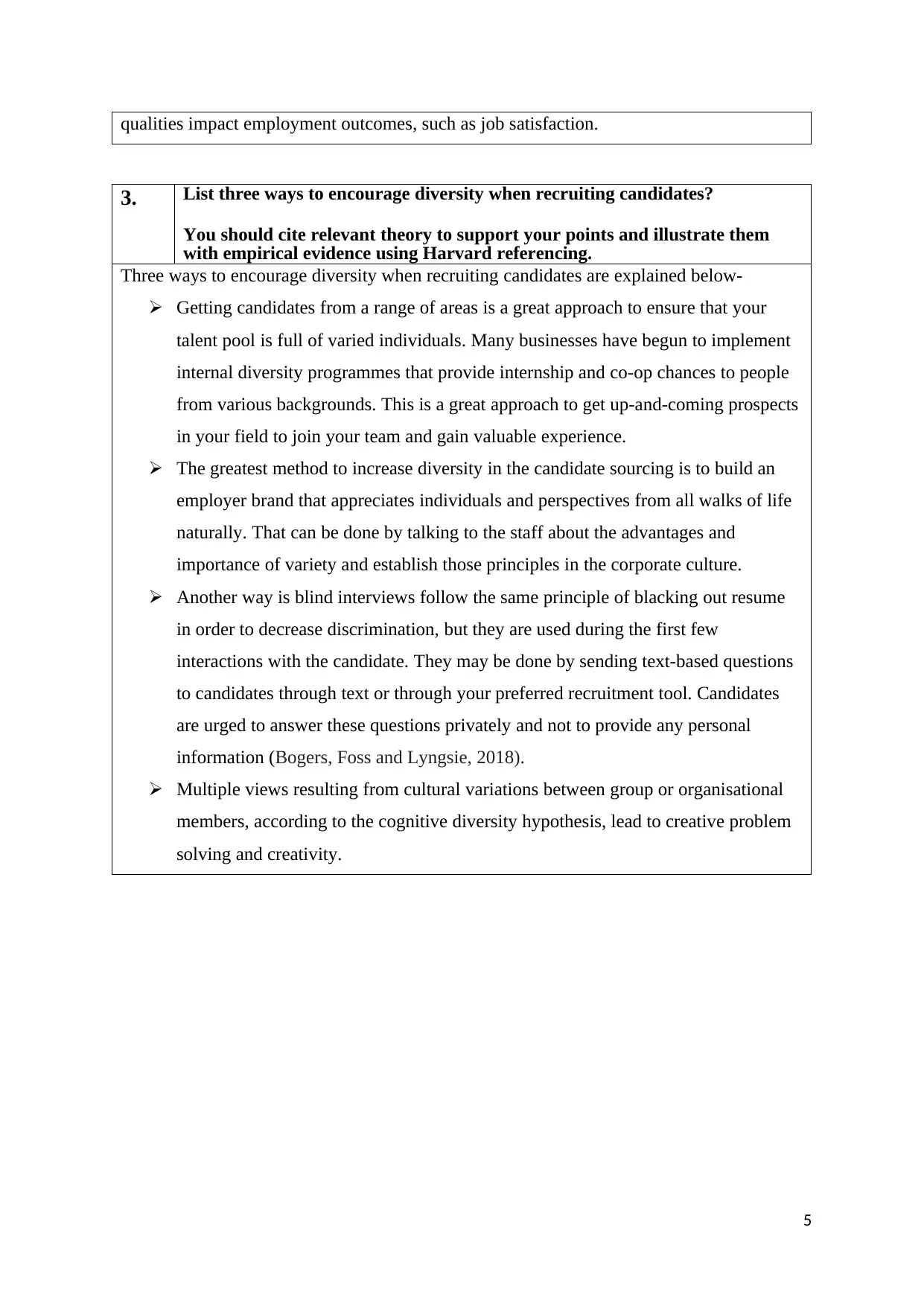
qualities impact employment outcomes, such as job satisfaction.
3. List three ways to encourage diversity when recruiting candidates?
You should cite relevant theory to support your points and illustrate them
with empirical evidence using Harvard referencing.
Three ways to encourage diversity when recruiting candidates are explained below-
Getting candidates from a range of areas is a great approach to ensure that your
talent pool is full of varied individuals. Many businesses have begun to implement
internal diversity programmes that provide internship and co-op chances to people
from various backgrounds. This is a great approach to get up-and-coming prospects
in your field to join your team and gain valuable experience.
The greatest method to increase diversity in the candidate sourcing is to build an
employer brand that appreciates individuals and perspectives from all walks of life
naturally. That can be done by talking to the staff about the advantages and
importance of variety and establish those principles in the corporate culture.
Another way is blind interviews follow the same principle of blacking out resume
in order to decrease discrimination, but they are used during the first few
interactions with the candidate. They may be done by sending text-based questions
to candidates through text or through your preferred recruitment tool. Candidates
are urged to answer these questions privately and not to provide any personal
information (Bogers, Foss and Lyngsie, 2018).
Multiple views resulting from cultural variations between group or organisational
members, according to the cognitive diversity hypothesis, lead to creative problem
solving and creativity.
5
3. List three ways to encourage diversity when recruiting candidates?
You should cite relevant theory to support your points and illustrate them
with empirical evidence using Harvard referencing.
Three ways to encourage diversity when recruiting candidates are explained below-
Getting candidates from a range of areas is a great approach to ensure that your
talent pool is full of varied individuals. Many businesses have begun to implement
internal diversity programmes that provide internship and co-op chances to people
from various backgrounds. This is a great approach to get up-and-coming prospects
in your field to join your team and gain valuable experience.
The greatest method to increase diversity in the candidate sourcing is to build an
employer brand that appreciates individuals and perspectives from all walks of life
naturally. That can be done by talking to the staff about the advantages and
importance of variety and establish those principles in the corporate culture.
Another way is blind interviews follow the same principle of blacking out resume
in order to decrease discrimination, but they are used during the first few
interactions with the candidate. They may be done by sending text-based questions
to candidates through text or through your preferred recruitment tool. Candidates
are urged to answer these questions privately and not to provide any personal
information (Bogers, Foss and Lyngsie, 2018).
Multiple views resulting from cultural variations between group or organisational
members, according to the cognitive diversity hypothesis, lead to creative problem
solving and creativity.
5
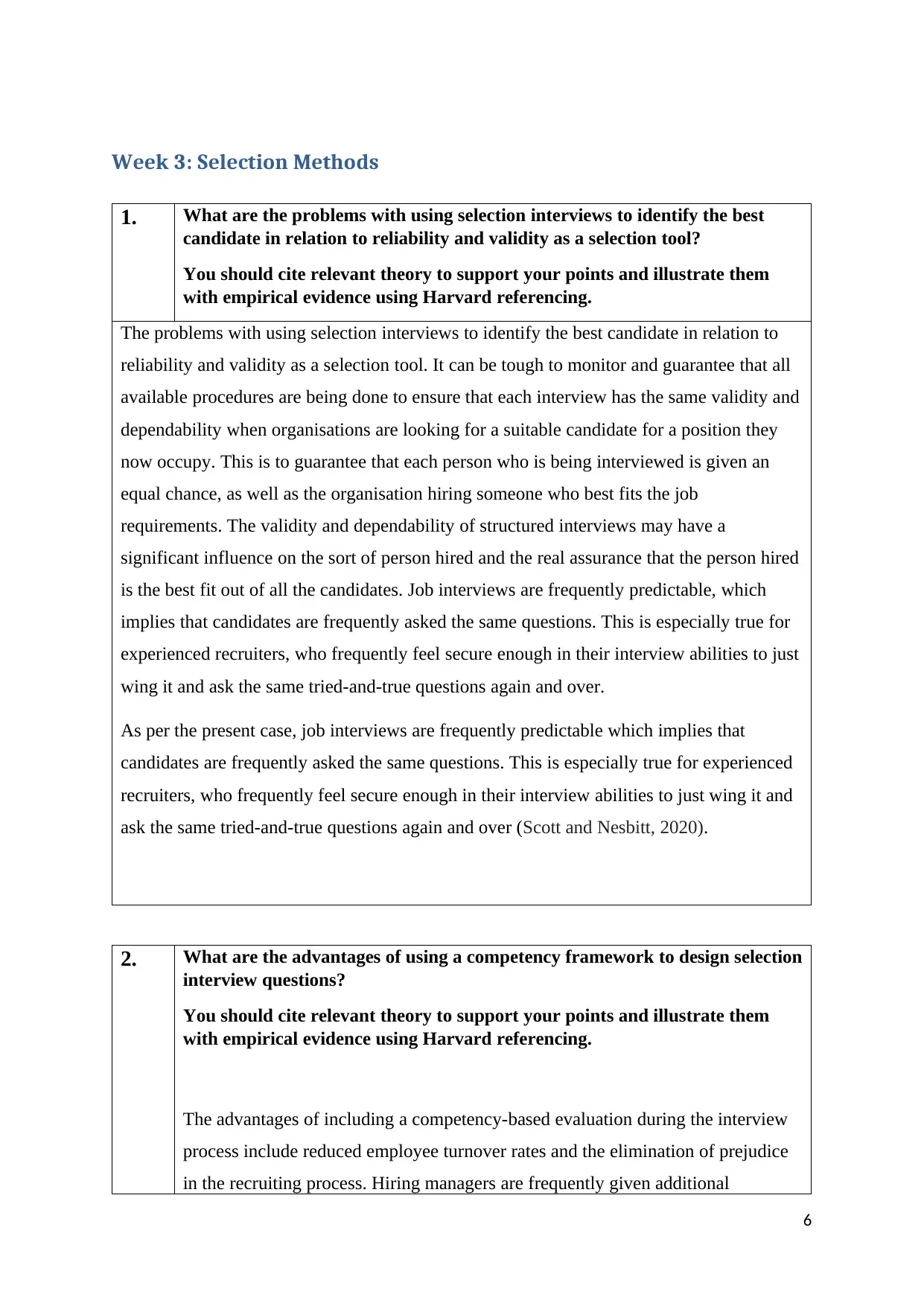
Week 3: Selection Methods
1. What are the problems with using selection interviews to identify the best
candidate in relation to reliability and validity as a selection tool?
You should cite relevant theory to support your points and illustrate them
with empirical evidence using Harvard referencing.
The problems with using selection interviews to identify the best candidate in relation to
reliability and validity as a selection tool. It can be tough to monitor and guarantee that all
available procedures are being done to ensure that each interview has the same validity and
dependability when organisations are looking for a suitable candidate for a position they
now occupy. This is to guarantee that each person who is being interviewed is given an
equal chance, as well as the organisation hiring someone who best fits the job
requirements. The validity and dependability of structured interviews may have a
significant influence on the sort of person hired and the real assurance that the person hired
is the best fit out of all the candidates. Job interviews are frequently predictable, which
implies that candidates are frequently asked the same questions. This is especially true for
experienced recruiters, who frequently feel secure enough in their interview abilities to just
wing it and ask the same tried-and-true questions again and over.
As per the present case, job interviews are frequently predictable which implies that
candidates are frequently asked the same questions. This is especially true for experienced
recruiters, who frequently feel secure enough in their interview abilities to just wing it and
ask the same tried-and-true questions again and over (Scott and Nesbitt, 2020).
2. What are the advantages of using a competency framework to design selection
interview questions?
You should cite relevant theory to support your points and illustrate them
with empirical evidence using Harvard referencing.
The advantages of including a competency-based evaluation during the interview
process include reduced employee turnover rates and the elimination of prejudice
in the recruiting process. Hiring managers are frequently given additional
6
1. What are the problems with using selection interviews to identify the best
candidate in relation to reliability and validity as a selection tool?
You should cite relevant theory to support your points and illustrate them
with empirical evidence using Harvard referencing.
The problems with using selection interviews to identify the best candidate in relation to
reliability and validity as a selection tool. It can be tough to monitor and guarantee that all
available procedures are being done to ensure that each interview has the same validity and
dependability when organisations are looking for a suitable candidate for a position they
now occupy. This is to guarantee that each person who is being interviewed is given an
equal chance, as well as the organisation hiring someone who best fits the job
requirements. The validity and dependability of structured interviews may have a
significant influence on the sort of person hired and the real assurance that the person hired
is the best fit out of all the candidates. Job interviews are frequently predictable, which
implies that candidates are frequently asked the same questions. This is especially true for
experienced recruiters, who frequently feel secure enough in their interview abilities to just
wing it and ask the same tried-and-true questions again and over.
As per the present case, job interviews are frequently predictable which implies that
candidates are frequently asked the same questions. This is especially true for experienced
recruiters, who frequently feel secure enough in their interview abilities to just wing it and
ask the same tried-and-true questions again and over (Scott and Nesbitt, 2020).
2. What are the advantages of using a competency framework to design selection
interview questions?
You should cite relevant theory to support your points and illustrate them
with empirical evidence using Harvard referencing.
The advantages of including a competency-based evaluation during the interview
process include reduced employee turnover rates and the elimination of prejudice
in the recruiting process. Hiring managers are frequently given additional
6
⊘ This is a preview!⊘
Do you want full access?
Subscribe today to unlock all pages.

Trusted by 1+ million students worldwide
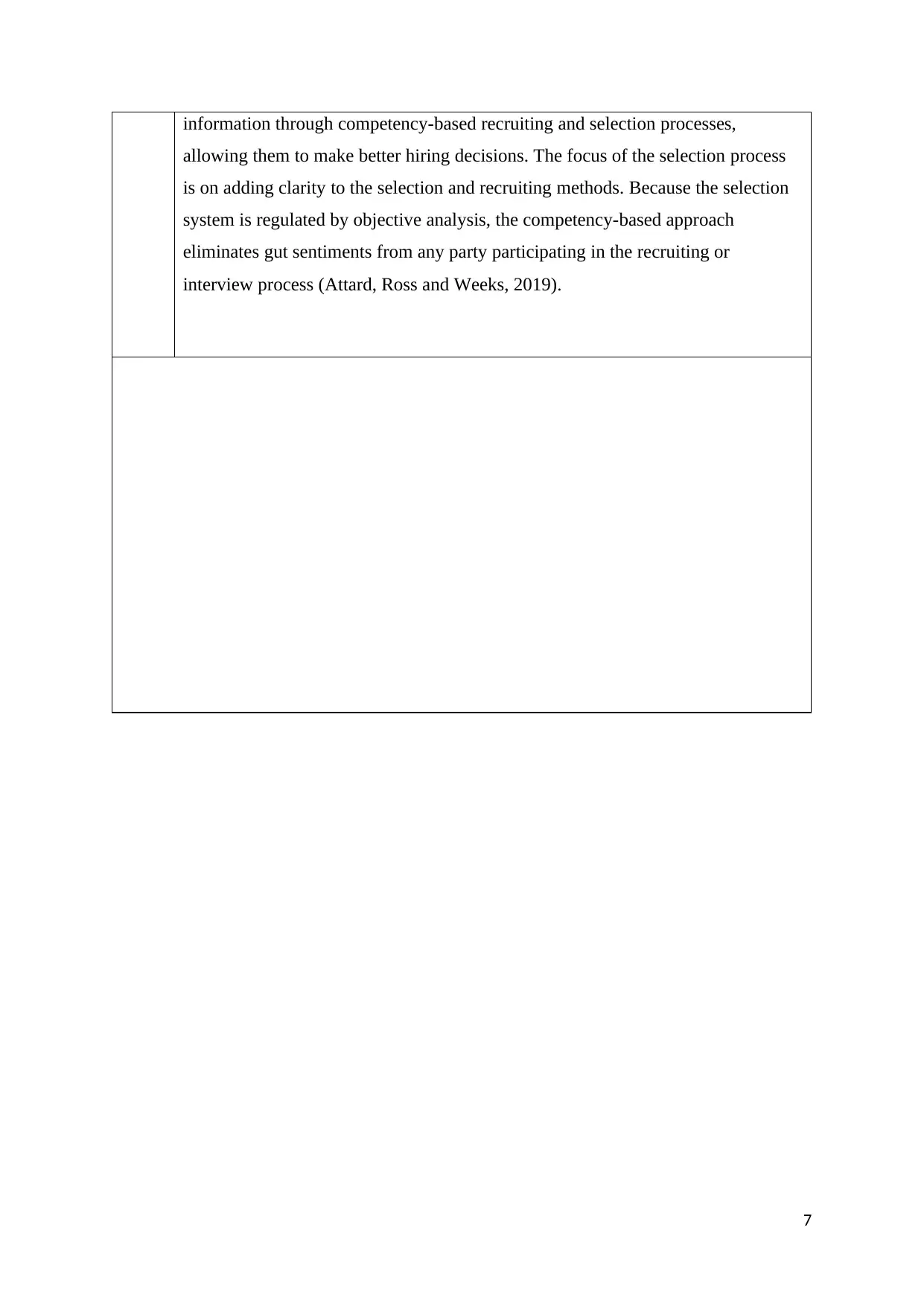
information through competency-based recruiting and selection processes,
allowing them to make better hiring decisions. The focus of the selection process
is on adding clarity to the selection and recruiting methods. Because the selection
system is regulated by objective analysis, the competency-based approach
eliminates gut sentiments from any party participating in the recruiting or
interview process (Attard, Ross and Weeks, 2019).
7
allowing them to make better hiring decisions. The focus of the selection process
is on adding clarity to the selection and recruiting methods. Because the selection
system is regulated by objective analysis, the competency-based approach
eliminates gut sentiments from any party participating in the recruiting or
interview process (Attard, Ross and Weeks, 2019).
7
Paraphrase This Document
Need a fresh take? Get an instant paraphrase of this document with our AI Paraphraser
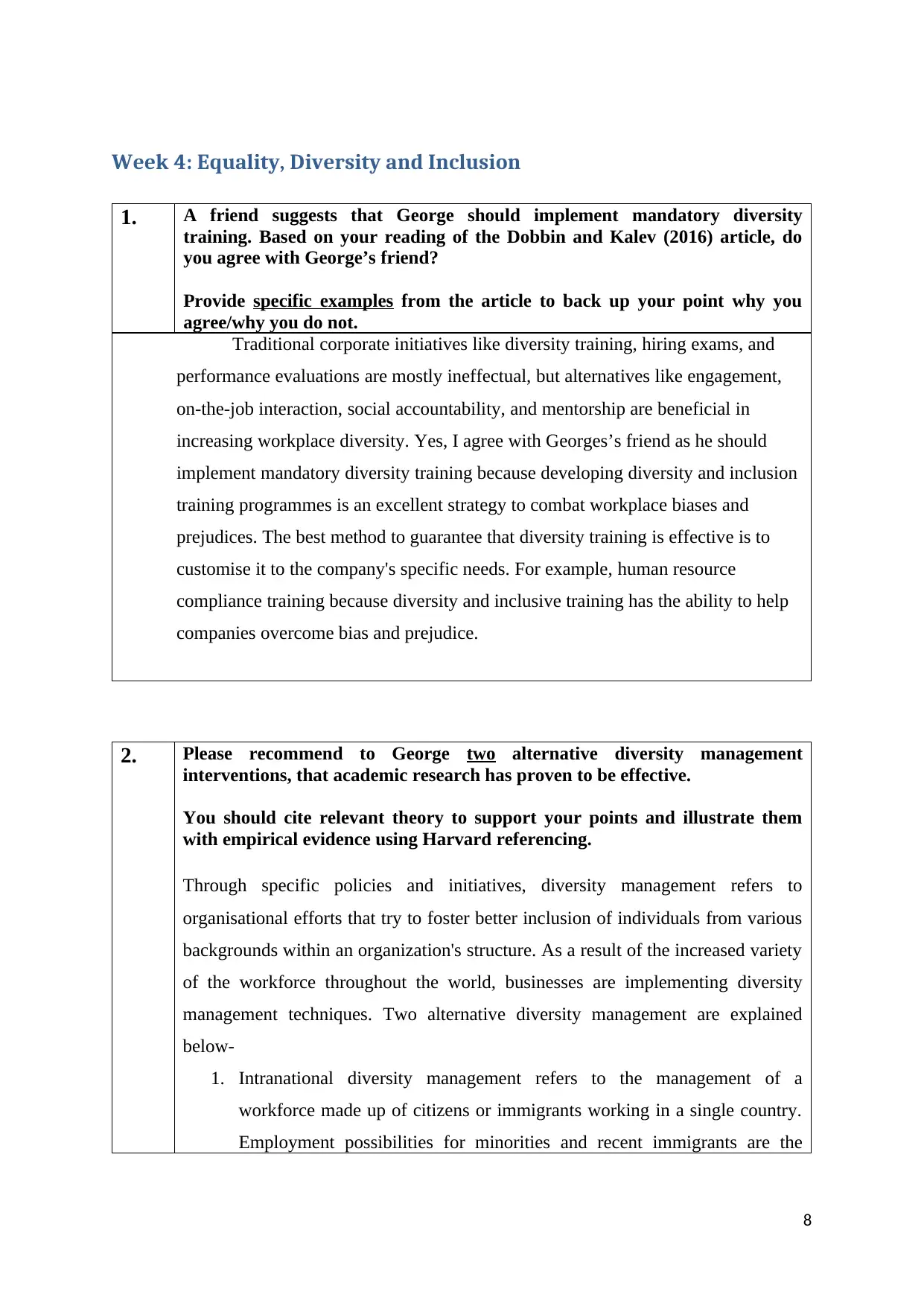
Week 4: Equality, Diversity and Inclusion
1. A friend suggests that George should implement mandatory diversity
training. Based on your reading of the Dobbin and Kalev (2016) article, do
you agree with George’s friend?
Provide specific examples from the article to back up your point why you
agree/why you do not.
Traditional corporate initiatives like diversity training, hiring exams, and
performance evaluations are mostly ineffectual, but alternatives like engagement,
on-the-job interaction, social accountability, and mentorship are beneficial in
increasing workplace diversity. Yes, I agree with Georges’s friend as he should
implement mandatory diversity training because developing diversity and inclusion
training programmes is an excellent strategy to combat workplace biases and
prejudices. The best method to guarantee that diversity training is effective is to
customise it to the company's specific needs. For example, human resource
compliance training because diversity and inclusive training has the ability to help
companies overcome bias and prejudice.
2. Please recommend to George two alternative diversity management
interventions, that academic research has proven to be effective.
You should cite relevant theory to support your points and illustrate them
with empirical evidence using Harvard referencing.
Through specific policies and initiatives, diversity management refers to
organisational efforts that try to foster better inclusion of individuals from various
backgrounds within an organization's structure. As a result of the increased variety
of the workforce throughout the world, businesses are implementing diversity
management techniques. Two alternative diversity management are explained
below-
1. Intranational diversity management refers to the management of a
workforce made up of citizens or immigrants working in a single country.
Employment possibilities for minorities and recent immigrants are the
8
1. A friend suggests that George should implement mandatory diversity
training. Based on your reading of the Dobbin and Kalev (2016) article, do
you agree with George’s friend?
Provide specific examples from the article to back up your point why you
agree/why you do not.
Traditional corporate initiatives like diversity training, hiring exams, and
performance evaluations are mostly ineffectual, but alternatives like engagement,
on-the-job interaction, social accountability, and mentorship are beneficial in
increasing workplace diversity. Yes, I agree with Georges’s friend as he should
implement mandatory diversity training because developing diversity and inclusion
training programmes is an excellent strategy to combat workplace biases and
prejudices. The best method to guarantee that diversity training is effective is to
customise it to the company's specific needs. For example, human resource
compliance training because diversity and inclusive training has the ability to help
companies overcome bias and prejudice.
2. Please recommend to George two alternative diversity management
interventions, that academic research has proven to be effective.
You should cite relevant theory to support your points and illustrate them
with empirical evidence using Harvard referencing.
Through specific policies and initiatives, diversity management refers to
organisational efforts that try to foster better inclusion of individuals from various
backgrounds within an organization's structure. As a result of the increased variety
of the workforce throughout the world, businesses are implementing diversity
management techniques. Two alternative diversity management are explained
below-
1. Intranational diversity management refers to the management of a
workforce made up of citizens or immigrants working in a single country.
Employment possibilities for minorities and recent immigrants are the
8
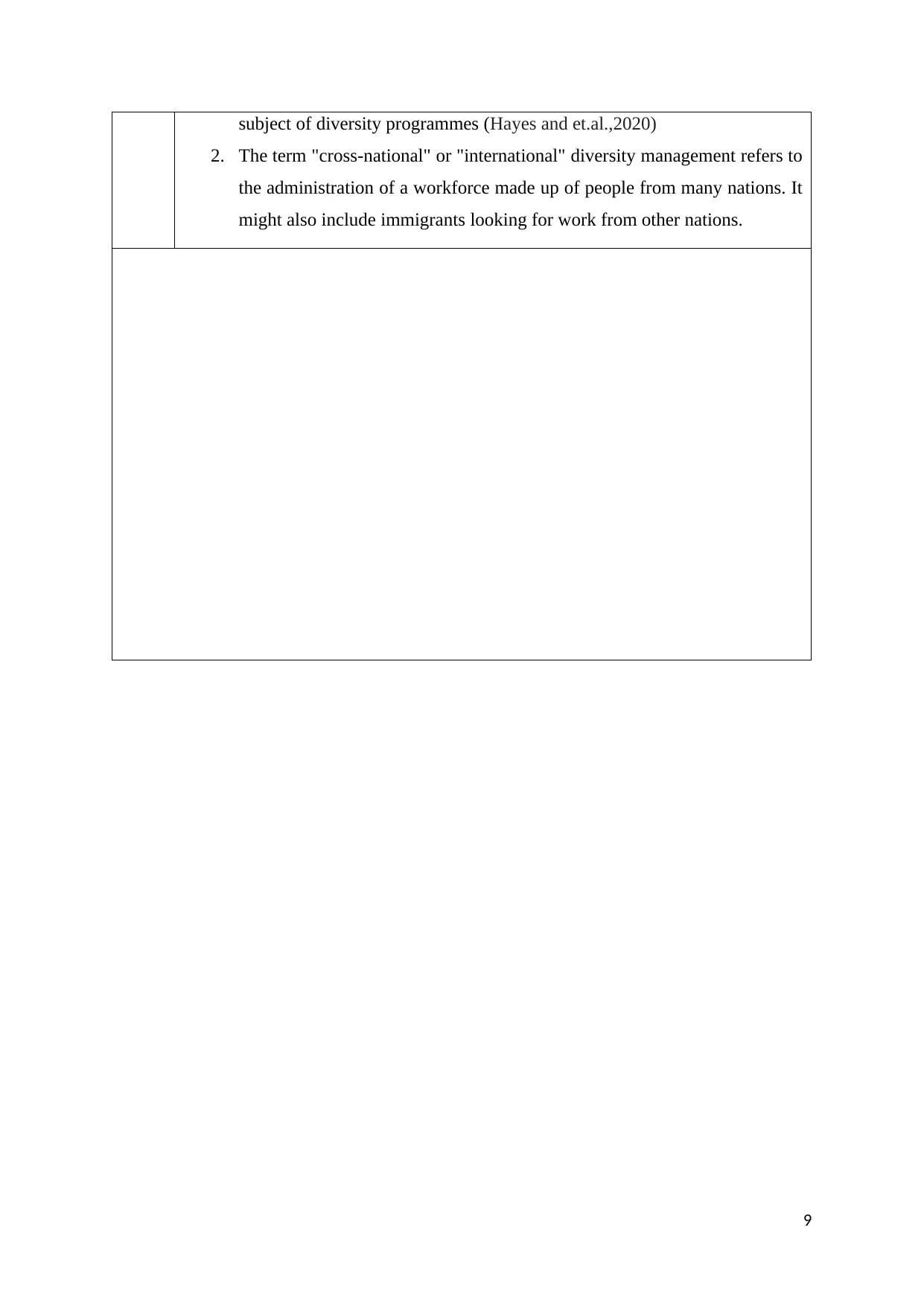
subject of diversity programmes (Hayes and et.al.,2020)
2. The term "cross-national" or "international" diversity management refers to
the administration of a workforce made up of people from many nations. It
might also include immigrants looking for work from other nations.
9
2. The term "cross-national" or "international" diversity management refers to
the administration of a workforce made up of people from many nations. It
might also include immigrants looking for work from other nations.
9
⊘ This is a preview!⊘
Do you want full access?
Subscribe today to unlock all pages.

Trusted by 1+ million students worldwide

Week 5: Skills, Training and Development
1. What are the challenges which Covid 19, has created for adult learners’
employability in the labour market?
The COVID-19-related problem is different from previous crises. Urban areas, especially
the city and big cities, have a higher proportion of potentially vulnerable jobs. Because the
impact is uneven at the local level, policy measures must be tailored to meet local
requirements, and recovery will take significantly longer.
The challenges which Covid 19, has created for adult learners’ employability in the labour
market as one of the biggest job crises since the Great Depression has emerged as a result
of the COVID-19 epidemic. The crisis has the potential to trigger poverty and inequalities,
with long-term consequences. Countries should now do all possible to prevent a social
disaster from developing as a result of the employment shortage. Rebuilding a stronger and
more resilient labour market is an investment in the future and future generations that must
be made.
2. Why is coaching by line managers important for the performance of their
teams?
What benefits does conducting induction for new joiners have for
organizations?
10
1. What are the challenges which Covid 19, has created for adult learners’
employability in the labour market?
The COVID-19-related problem is different from previous crises. Urban areas, especially
the city and big cities, have a higher proportion of potentially vulnerable jobs. Because the
impact is uneven at the local level, policy measures must be tailored to meet local
requirements, and recovery will take significantly longer.
The challenges which Covid 19, has created for adult learners’ employability in the labour
market as one of the biggest job crises since the Great Depression has emerged as a result
of the COVID-19 epidemic. The crisis has the potential to trigger poverty and inequalities,
with long-term consequences. Countries should now do all possible to prevent a social
disaster from developing as a result of the employment shortage. Rebuilding a stronger and
more resilient labour market is an investment in the future and future generations that must
be made.
2. Why is coaching by line managers important for the performance of their
teams?
What benefits does conducting induction for new joiners have for
organizations?
10
Paraphrase This Document
Need a fresh take? Get an instant paraphrase of this document with our AI Paraphraser
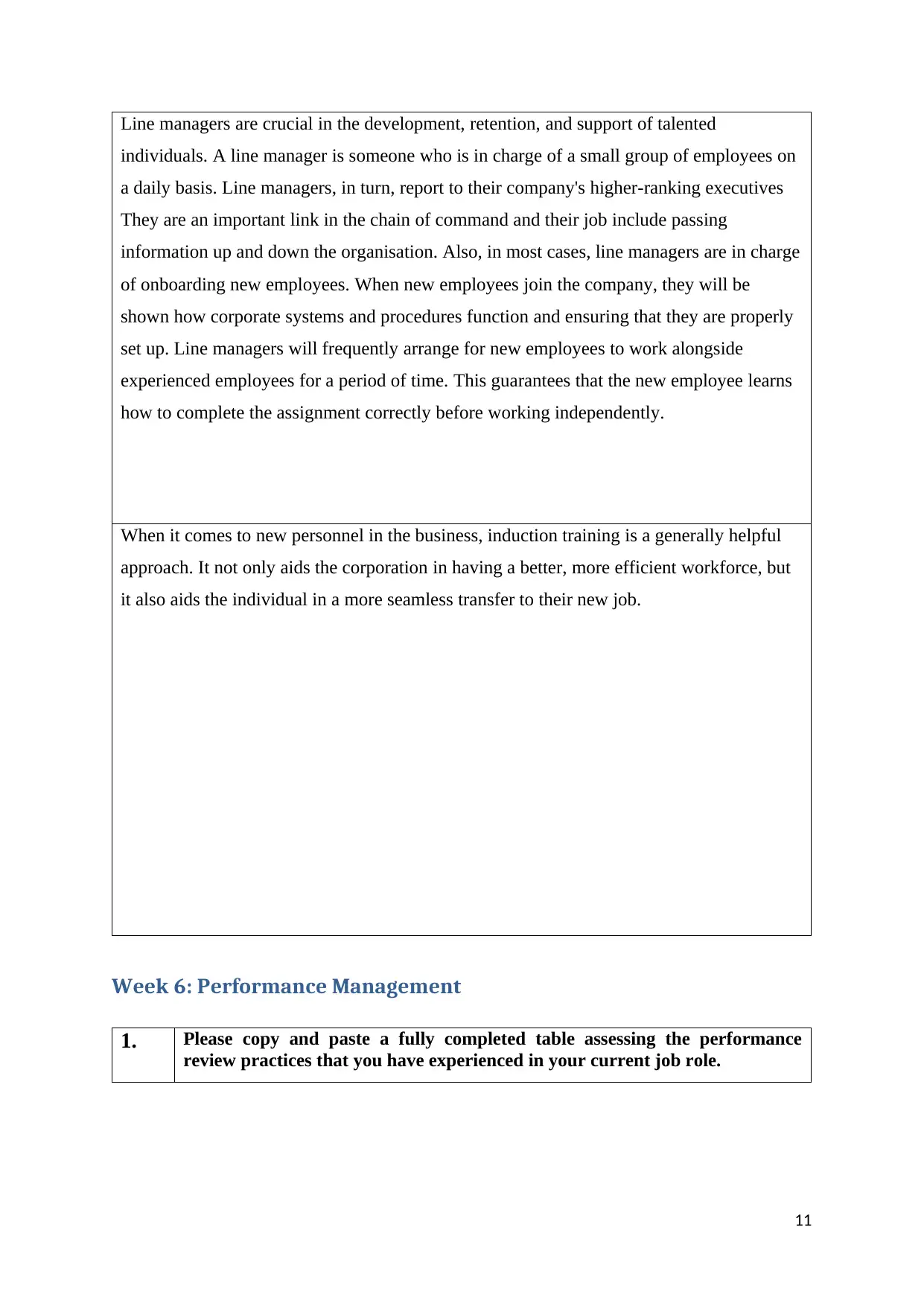
Line managers are crucial in the development, retention, and support of talented
individuals. A line manager is someone who is in charge of a small group of employees on
a daily basis. Line managers, in turn, report to their company's higher-ranking executives
They are an important link in the chain of command and their job include passing
information up and down the organisation. Also, in most cases, line managers are in charge
of onboarding new employees. When new employees join the company, they will be
shown how corporate systems and procedures function and ensuring that they are properly
set up. Line managers will frequently arrange for new employees to work alongside
experienced employees for a period of time. This guarantees that the new employee learns
how to complete the assignment correctly before working independently.
When it comes to new personnel in the business, induction training is a generally helpful
approach. It not only aids the corporation in having a better, more efficient workforce, but
it also aids the individual in a more seamless transfer to their new job.
Week 6: Performance Management
1. Please copy and paste a fully completed table assessing the performance
review practices that you have experienced in your current job role.
11
individuals. A line manager is someone who is in charge of a small group of employees on
a daily basis. Line managers, in turn, report to their company's higher-ranking executives
They are an important link in the chain of command and their job include passing
information up and down the organisation. Also, in most cases, line managers are in charge
of onboarding new employees. When new employees join the company, they will be
shown how corporate systems and procedures function and ensuring that they are properly
set up. Line managers will frequently arrange for new employees to work alongside
experienced employees for a period of time. This guarantees that the new employee learns
how to complete the assignment correctly before working independently.
When it comes to new personnel in the business, induction training is a generally helpful
approach. It not only aids the corporation in having a better, more efficient workforce, but
it also aids the individual in a more seamless transfer to their new job.
Week 6: Performance Management
1. Please copy and paste a fully completed table assessing the performance
review practices that you have experienced in your current job role.
11
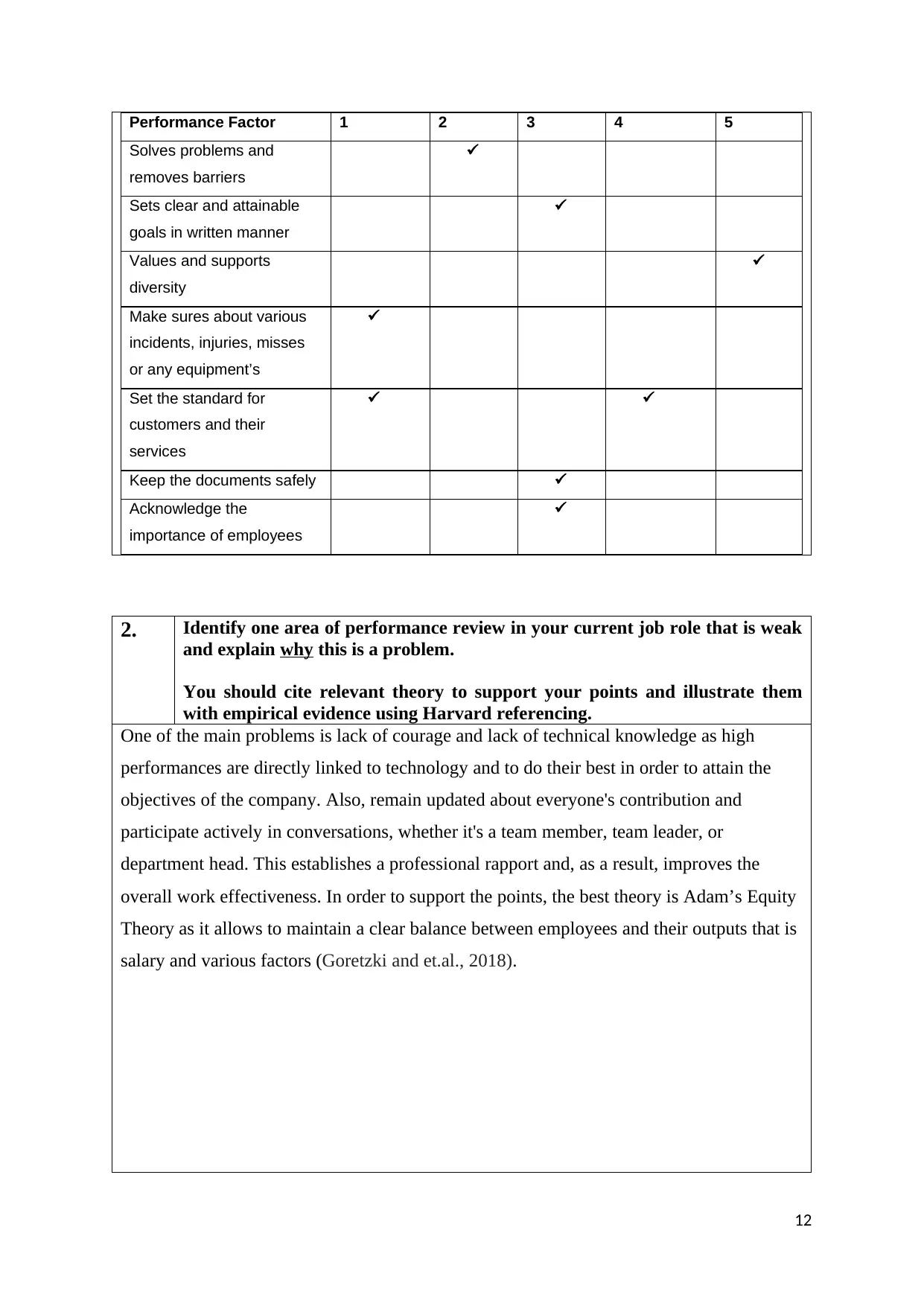
Performance Factor 1 2 3 4 5
Solves problems and
removes barriers
Sets clear and attainable
goals in written manner
Values and supports
diversity
Make sures about various
incidents, injuries, misses
or any equipment’s
Set the standard for
customers and their
services
Keep the documents safely
Acknowledge the
importance of employees
2. Identify one area of performance review in your current job role that is weak
and explain why this is a problem.
You should cite relevant theory to support your points and illustrate them
with empirical evidence using Harvard referencing.
One of the main problems is lack of courage and lack of technical knowledge as high
performances are directly linked to technology and to do their best in order to attain the
objectives of the company. Also, remain updated about everyone's contribution and
participate actively in conversations, whether it's a team member, team leader, or
department head. This establishes a professional rapport and, as a result, improves the
overall work effectiveness. In order to support the points, the best theory is Adam’s Equity
Theory as it allows to maintain a clear balance between employees and their outputs that is
salary and various factors (Goretzki and et.al., 2018).
12
Solves problems and
removes barriers
Sets clear and attainable
goals in written manner
Values and supports
diversity
Make sures about various
incidents, injuries, misses
or any equipment’s
Set the standard for
customers and their
services
Keep the documents safely
Acknowledge the
importance of employees
2. Identify one area of performance review in your current job role that is weak
and explain why this is a problem.
You should cite relevant theory to support your points and illustrate them
with empirical evidence using Harvard referencing.
One of the main problems is lack of courage and lack of technical knowledge as high
performances are directly linked to technology and to do their best in order to attain the
objectives of the company. Also, remain updated about everyone's contribution and
participate actively in conversations, whether it's a team member, team leader, or
department head. This establishes a professional rapport and, as a result, improves the
overall work effectiveness. In order to support the points, the best theory is Adam’s Equity
Theory as it allows to maintain a clear balance between employees and their outputs that is
salary and various factors (Goretzki and et.al., 2018).
12
⊘ This is a preview!⊘
Do you want full access?
Subscribe today to unlock all pages.

Trusted by 1+ million students worldwide
1 out of 23
Related Documents
Your All-in-One AI-Powered Toolkit for Academic Success.
+13062052269
info@desklib.com
Available 24*7 on WhatsApp / Email
![[object Object]](/_next/static/media/star-bottom.7253800d.svg)
Unlock your academic potential
Copyright © 2020–2025 A2Z Services. All Rights Reserved. Developed and managed by ZUCOL.




